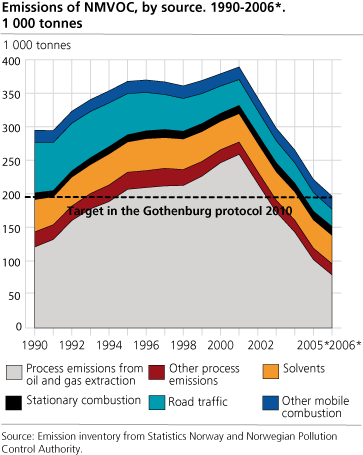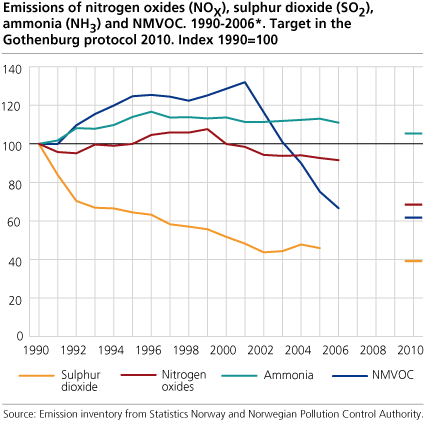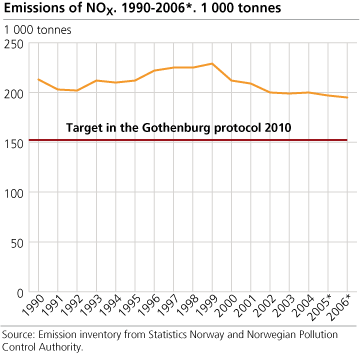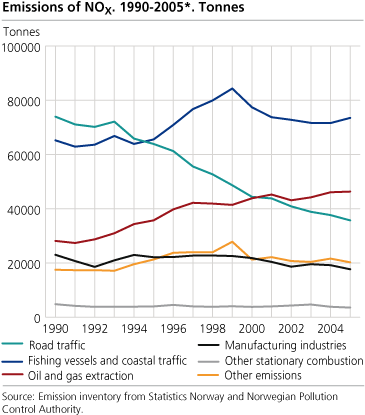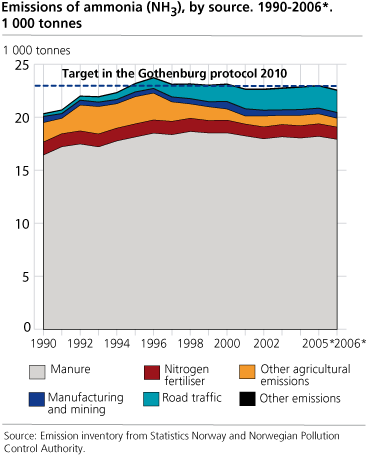Content
Published:
This is an archived release.
Emission target in reach
Considerable cuts in emissions of hydrocarbons (NMVOC) from loading of oil on the Norwegian continental shelf have brought Norway within reach of the emission target in the Gothenburg Protocol. Emissions of nitrogen oxides (NOX) were also reduced in 2006, although the emission target is still some way off.
This appears from new preliminary emission calculations produced by Statistics Norway in close cooperation with the Norwegian Pollution Control Authority. The uncertainty of the preliminary figures is discussed later in the article.
NMVOC strongly reduced
The emissions of NMVOC were reduced by slightly more than 11 per cent from 2005 to 2006, and amounted to 196 000 tonnes in 2006. The large reduction means that Norway has almost reached the level of the emission target for 2010, stated in the Gothenburg Protocol. According to this, Norway's NMVOC emissions in 2010 shall not exceed 195 000 tonnes. NMVOC emissions peaked in 2001, when they amounted to 389 000 tonnes; in other words, the emissions have been almost halved in five years. The decline from 2001 has mainly been caused by reduced emissions from loading and storing of crude oil on the continental shelf. This was also the main reason for the reduction from 2005 to 2006.
The Norwegian Pollution Control Authority has required measures to reduce NMVOC emissions from loading and storing of crude oil. The measures are being introduced in the period 2004-2007, and within the end of 2007, 95 per cent of all loading of oil shall take place using technology that reduces NMVOC emissions.
Emissions of NMVOC have been reduced significantly in recent years and this development continued in 2006. The reduction is due to restrictions on exhaust gas, particularly the mandatory use of catalytic converters in petrol cars from 1989 and subsequent stricter regulations. In addition, the number of petrol cars has gradually decreased. The number of diesel cars is increasing considerably, but these have much lower NMVOC emissions than even modern petrol cars equipped with catalytic converters.
|
Emission ceiling 2010 according to the Gothenburg Protocol and status 1990 and 2006.
Tonnes (per cent) |
| Component | Emissions 1990 | Emissions 2006 | Emission ceiling 2010 | Necessary reduction 2006-2010 | |||||||||||||||||||||||||||||||||||
|---|---|---|---|---|---|---|---|---|---|---|---|---|---|---|---|---|---|---|---|---|---|---|---|---|---|---|---|---|---|---|---|---|---|---|---|---|---|---|---|
| Nitrogen oxides (NOX) | 212 524 | 194 506 | 156 000 | 39 000 tonnes (20 per cent) | |||||||||||||||||||||||||||||||||||
| NMVOC | 294 875 | 196 345 | 195 000 | 1 000 tonnes (1 per cent) | |||||||||||||||||||||||||||||||||||
| Ammonia (NH3) | 20 375 | 22 610 | 23 000 | Emission ceiling reached at the moment | |||||||||||||||||||||||||||||||||||
| Source: Emission inventory from Statistics Norway and Norwegian Pollution Control Authority. |
Reduced NOx emissions from road traffic and manufacturing industries
In 2006, Norwegian NOX emissions amounted to 195 000 tonnes, which is 1 per cent lower than in 2005. There are two main reasons for the decline. A significant part of the reduction is due to lower emissions from the manufacturing industries, most likely caused by lower production in some industries and closing down of a couple of important plants. The other main reason is reduced emissions from road traffic, due to specific environmental measures. The share of cars equipped with catalytic converters is still rising (see below), and heavy vehicles have reduced their emissions because of new restrictions on exhaust gas.
NOX emissions have been reduced by 8.5 per cent since 1990, but must be lowered by a further 20 per cent, or 39 000 tonnes, within 2010, if Norway shall fulfil the targets of the Gothenburg Protocol (156 000 tonnes).
Three emission sources caused 80 per cent
The three emission sources domestic sea transport and fishing, oil and gas activities and road traffic together accounted for almost 80 per cent of NOx emissions in 2005. The remainder came mainly from oil used for heating and other combustion, air traffic and use of motorised equipment. Domestic sea transport and fishing had the largest NOX emissions in 2005, with 73 000 tonnes or 37 per cent of total emissions. The emissions from this source have increased considerably since 1990, and are now 13 per cent above the 1990 level. Fishing caused 23 000 tonnes, and the rest came from coastal traffic, ferries, supply ships, mobile oil rigs etc. Measures to reduce NOX emissions from domestic sea transport and fishing include cleansing of exhaust gases (SCR) and motor technical reconstruction of ships.
In 2005, 46 000 tonnes, or 24 per cent of the NOx emissions, came from oil and gas activities. As for domestic sea transport and fishing, this is an important emission source, not only because it has large emissions, but also because the emissions have grown considerably since 1990: The emissions from oil and gas activities have increased by 65 per cent in the period. Measures to reduce these emissions can for instance be installation of low-NOX turbines (Dry low emission - DLE).
Even though Norwegian motorists drive longer distances than ever before, NOX emissions from road traffic have been more than halved since 1990. The main cause for this decline is the mandatory introduction of catalytic converters in petrol vehicles in 1989 combined with stricter rules in subsequent years. The emissions have decreased steadily since catalytic converters became mandatory. In 2005, 36 000 tonnes, or 18 per cent of the total NOx emissions, came from road traffic. The emissions from heavy diesel vehicles have also decreased, following the introduction of emission limits for heavy vehicles in 1993.
NOX tax introduced in January 2007In autumn 2006, the Norwegian Parliament passed a tax on emissions of NOX from January 1 2007. The tax amounts to NOK 15 per kg NOX . emitted. It comprises ships, fishing vessels, air traffic and diesel railways, and also engines, boilers and turbines in energy plants in the manufacturing industries. For practical reasons, the tax only applies to large units. In addition, NOx tax is imposed on flaring offshore and on oil and gas installations on shore. The tax covers approximately 55 per cent of the total Norwegian NOx emissions. The tax is geographically delimited in accordance with the Gothenburg Protocol. This implies that emissions from foreign sea and air transport not are covered, for instance. The introduction of the tax will probably not by itself suffice to reach the emission target in the Gothenburg Protocol (156 000 tonnes in 2010). Thereby, further measures or strengthening of existing measures will be needed to fulfil the obligation. |
Small decrease in ammonia emissions
The emissions of ammonia were slightly reduced from 2005 to 2006, and totalled 22 600 tonnes in 2006. This is slightly below the target in the Gothenburg Protocol (23 000 tonnes).
Preliminary figures
The figures presented in this article are preliminary, but can be regarded as quite certain, particularly with regard to the total emissions. Detailed tables with distributions between source and industry will not be published until February 2008. The main emission sources for 2005 are described above.
Greenhouse gas figures also published today
Greenhouse gas emissions down 0.8 per cent
Documentation of the emission accounts
Tables:
The statistics is published with Emissions to air.
Contact
-
Statistics Norway's Information Centre
E-mail: informasjon@ssb.no
tel.: (+47) 21 09 46 42

